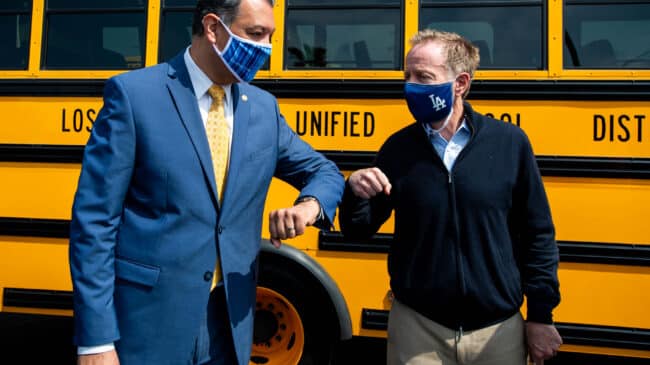Despite having 160,000 fewer students enrolled this school year, California’s public schools will soon be flush with federal funds from COVID-19-related stimulus spending. If the education-related hiring surge of recent years continues, many school districts will likely be caught looking over a fiscal cliff when the federal stimulus dollars dry up.
Overall, 2.6% of California’s public school students didn’t return for the 2020-2021 school year as many families opted for private schools and homeschooling during the pandemic. But the state’s declining enrollment trend started well before the pandemic. Just a few years ago, the Department of Finance predicted a statewide enrollment drop of nearly 7% by 2028-2029, with about half of all counties losing students, and Los Angeles County dropping by nearly 250,000 students.
Unlike in the private sector, where companies are forced to innovate in response to falling demand, public education was rewarded with unprecedented funding primarily to help combat learning loss and kids falling behind during the pandemic. Some of this learning loss could’ve been mitigated had state and local leaders followed the science on reopening schools safely earlier instead of succumbing to a variety of non-evidence-based fears and teacher unions’ demands.
The recent federal American Rescue Plan Act sends over $15 billion to California school districts, on top of the funding in previous COVID-19 relief packages. These federal stimulus dollars are temporary and must be spent by 2024, so it would be foolish to allocate them in ways that increase schools’ long-term commitments—like hiring new full-time, permanent workers. Unfortunately, a new analysis by Georgetown University’s Edunomics Lab finds many school districts are doing just that—adding new counselors, nurses, and staffers, and plugging their previous budget holes.
For school districts with declining enrollments, whose per-pupil state funding levels will go down in the coming years as their student counts decrease, this is especially irresponsible. The Los Angeles Unified School District’s negotiations with the United Teachers Union of Los Angeles (UTLA) on re-opening next fall, for example, reportedly includes discussions on spending federal funds in several of these irresponsible ways.
LAUSD lost 22,000 students this year and is expected to lose thousands more in the years ahead. Between 2013 and 2019 LAUSD’s enrollment fell by more than 80,300 students, but the number of staff employed by the district actually grew by 6,322—an 8.3% increase. Research indicates that many of these hires were non-instructional employees, which means that thousands of administrative and support personnel were hired to oversee fewer students.
Yet, despite the school district’s decreasing enrollment and chronic financial problems, UTLA is now demanding thousands of new teachers and support staff as well as on-going salary increases for staffers. Doing so would only make LAUSD’s long-term financial outlook more interminable.
Los Angeles Unified isn’t alone. Despite over five consecutive years of decreasing K-12 enrollment in California, similar trends in increased staffing levels and costs can be observed statewide, where there are now thousands of more instruction coordinators than principals and nearly one instructional aid for every three teachers.
In recent years, school districts might have gotten away with this since California was dumping billions of new dollars into its school finance system. But the federal government’s stimulus funding is temporary. A few years from now, where will school districts get the money to pay for the ongoing salaries and benefits of additional staffers hired with one-time stimulus money?
Public schools are also in a time of tremendous uncertainty. Many families were frustrated by public school districts’ COVID-19 responses and a lot moved their kids to homeschooling, private schools, and other educational options. It’s unclear how many will return to public schools when California’s classrooms finally open up this fall.
The temporary infusion of stimulus money coupled with declining enrollment means district officials must be strategic about how they spend one-time federal funding. Rather than adding unneeded staff and bureaucracy, school districts, like LAUSD, should be looking at ways to spend these dollars to help students catch up without creating a fiscal cliff.
A version of this column previously appeared in the Los Angeles Daily News.

